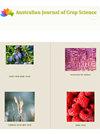Comparison between Matheron and Genton semivariance function estimators in spatial modeling of soybean yield
Q3 Agricultural and Biological Sciences
引用次数: 0
Abstract
In precision agriculture, interpolations are performed to map soybean yield, which facilitates decision making. Among the existing methods, geostatistics prevails, which uses information from the data’s spatial structure to generate interpolated maps. The spatial dependence structure is modeled based on the semivariogram, with the Matheron semivariance estimator being the most commonly used function. However, studies show unreliability in the presence of outliers; therefore, other researchers propose an alternative use of the Genton semivariance function estimator. Despite several studies comprising comparative works involving both estimators of the semivariance function, there are only a few comparative studies considering theoretical semivariograms with cyclical behavior, such as the Wave model. This study, therefore, aims to compare these two estimators considering adjustments of the Wave model in soybean yield data, when containing an outlier. The spatial dependence measure index was used to measure the degree of the model’s spatial dependence and the weighted Kappa index to assess the similarity of maps generated through kriging. It was possible to verify that the outlier removal was more impactful in the modeling considering the Matheron semivariance function estimator, thus confirming the robustness of the Genton semivariance function estimator大豆产量空间模型中Matheron和Genton半方差函数估计量的比较
在精准农业中,进行插值来绘制大豆产量图,这有助于决策。在现有的方法中,以地质统计学为主,它利用数据的空间结构信息生成插值图。空间依赖结构基于半方差函数建模,其中最常用的函数是Matheron半方差估计。然而,研究表明,在存在异常值时不可靠;因此,其他研究人员提出了Genton半方差函数估计器的另一种用途。尽管有几项研究包括涉及半方差函数的两个估计量的比较工作,但只有少数比较研究考虑具有周期性行为的理论半方差函数,如波浪模型。因此,本研究的目的是在包含异常值的情况下,考虑大豆产量数据中波浪模型的调整,对这两种估计进行比较。空间依赖度量指数用来衡量模型的空间依赖程度,加权Kappa指数用来评估克里格生成的地图的相似性。考虑到Matheron半方差函数估计量,可以验证离群值去除在建模中更有效,从而证实了Genton半方差函数估计量的鲁棒性
本文章由计算机程序翻译,如有差异,请以英文原文为准。
求助全文
约1分钟内获得全文
求助全文
来源期刊

Australian Journal of Crop Science
农林科学-农艺学
CiteScore
1.20
自引率
0.00%
发文量
75
审稿时长
3.5 months
期刊介绍:
Information not localized
 求助内容:
求助内容: 应助结果提醒方式:
应助结果提醒方式:


